18 December 2024 : Daily Current Affairs
1. Private aviation is releasing more than its ‘fair share’ of emissions
- 1. Private aviation is releasing more than its ‘fair share’ of emissions
- 2. The Constitution On minority rights
- 3. Government Introduces Bills to Pave the Way for “One Nation, One Election”
- 4. Arctic Tundra Shifts from Carbon Sink to Source, Worsening Global Climate Crisis
- 5. Doubling the income of farmers
- PRELIMS FACTS
- 1. Rare Sighting of Wroughton’s Free-Tailed Bat in Delhi’s Yamuna Biodiversity Park
- 2. France rushes aid to Mayotte after cyclone
- 3. Financial Support for Rural Women
(Source – The Hindu, International Edition – Page No. – 7)
| Context |
|
Aviation Sector and Greenhouse Gas Emissions
- If considered a country, the aviation sector would rank among the top 10 global greenhouse gas emitters.
- Air travel is one of the most polluting transportation modes due to high carbon dioxide and nitrogen oxide emissions, as well as the effects of vapour trails and atmospheric gases.
| Private Jets and Their High Carbon Footprint |
|
Private Aircraft in India
- India had 112 private planes as of March 2024, with a ratio of 0.01 private aircraft per lakh population.
- While this ratio is lower than countries like the U.S. (5.45) and Switzerland (3.76), India ranks among the top 20 nations in private aircraft ownership and leads among low-middle-income countries.
- This trend is driven by India’s rapid economic growth and its ranking as the third-largest country in terms of billionaires.
Private Jet Usage and Global Trends
- Researchers analyzed private jet usage at events like the World Economic Forum and FIFA World Cup, finding 47% of flights were for distances under 500 km.
- About 19% of flights were shorter than 200 km, including empty flights or those delivering goods.
- Leisure travel via private jets peaks during summer months, particularly to destinations like Ibiza and Nice.
Decarbonizing Aviation
- India launched initiatives like UDAN and NABH to enhance connectivity and airport capacity.
- Efforts to use sustainable aviation fuels (SAFs) include trials by SpiceJet in 2018 and Air Asia in 2023. However, SAF commercialization faces challenges like high costs and limited availability.
Future Solutions
- Hydrogen and electrification are being explored, but implementation faces challenges like infrastructure redesign and battery dependency.
- Alcohol-to-jet fuel is a promising medium-term solution, especially using surplus sugar for ethanol production, which could meet 15–20% of India’s aviation fuel demand by 2050 without negative agricultural impacts.
| Practice Question: Analyze the environmental challenges posed by the aviation industry, particularly private aviation, and discuss the potential of alternative fuels and technologies in reducing its carbon footprint. (150 Words /10 marks) |
2. The Constitution On minority rights
(Source – The Hindu, International Edition – Page No. – 10)
| Topic: GS2 – Indian Polity |
| Context |
|
Introduction to Minority Rights
- Minority rights are critical for democracy, emphasizing equality and the preservation of diversity.
- The UN adopted the ‘Declaration on the Rights of Minorities’ on December 18, 1992, celebrated globally as Minority Rights Day.
- Franklin Roosevelt emphasized that democracy cannot survive without recognizing minority rights.
Historical Origin of Minority Rights
- 19th Century Developments:
- Article 19 of Austria’s Constitutional Law (1867) and Hungary’s Act XLIV (1868) recognized the rights of ethnic minorities.
- The Swiss Constitution (1874) granted equal rights to its three national languages.
- Post-World War I Treaties:
- Peace treaties included minority protections for nations like Poland, Romania, and Yugoslavia.
- Nations such as Albania and Finland voluntarily pledged to protect their minorities.
- Universal Declaration of Human Rights (1948):
- Article 27 affirms every individual’s right to community and cultural participation.
| Minority Rights in India’s Constitution |
|
Judicial Interpretation of Minority Rights
- Aligarh Muslim University Case (2024): Article 30 was upheld as a ‘facet of equality.’
- St. Xavier’s College Case (1974): Affirmed equality between majority and minority through Article 30.
- Keshavananda Bharati Case (1973): Declared minority rights as part of the Constitution’s basic structure.
- Courts have consistently ruled that minority institutions, including pre-Constitution entities, deserve protection.
| Defining a Minority |
|
Rationale for Minority Rights
- Focuses on the preservation of diversity and the dignity of individuals through community viability.
- Rights under Articles 14-18, 19, and 25 are insufficient without additional protections under Articles 29 and 30.
- The Supreme Court permits regulations to prevent maladministration and uphold institutional excellence.
Conclusion
- Minority rights are integral to democratic functioning, fostering equality and ensuring cultural preservation.
- These provisions reinforce India’s multicultural ethos while maintaining balance through judicial oversight.
| PYQ: Whether National Commission for Scheduled Castes (NCSCJ) can enforce the implementation of constitutional reservation for the Scheduled Castes in the religious minority institutions? Examine. (150 words/10m) (UPSC CSE (M) GS-2 2018) |
| Practice Question: Examine the constitutional provisions and judicial interpretations that uphold minority rights in India. How do these provisions contribute to fostering equality and inclusivity in a diverse society? (250 Words /15 marks) |
3. Government Introduces Bills to Pave the Way for “One Nation, One Election”
(Source: Indian Express; Section: Explained; Page: 17)
| Topic: GS2 – Polity |
| Context: |
|
Analysis of News:
Key Takeaways from the Bills
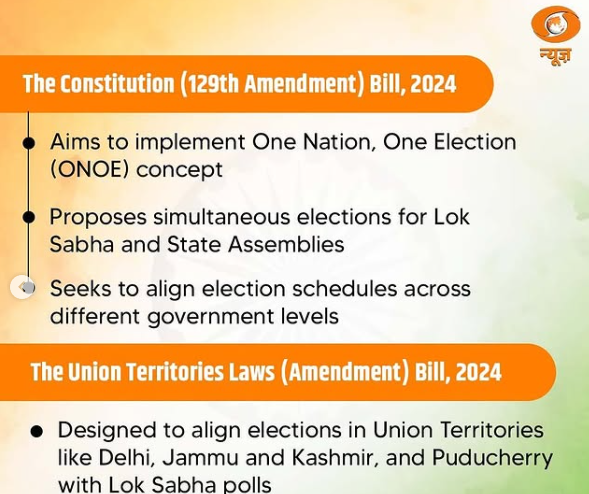
Scope and Timeline
- The Bills focus on Lok Sabha and state Assemblies, excluding municipal elections.
- Simultaneous polls can only realistically commence from the 2034 election cycle after the 18th and 19th Lok Sabhas complete their full terms.
Constitutional Changes Required
- Amendments to Articles 82, 83, 172, and 372 introduce Article 82A, facilitating the synchronization of elections.
- These amendments require a special majority in both Houses of Parliament.
Provisions for Simultaneous Elections
Article 82A:
- Aligns state Assembly elections with Lok Sabha terms, potentially curtailing the tenure of some Assemblies.
- Empowers the Election Commission to defer elections in exceptional cases, ensuring Assembly terms align with the Lok Sabha.
Mid-term Polls:
- If the Lok Sabha or a state Assembly is dissolved early, subsequent elections will only cover the unexpired term of the dissolved body.
Union Territories and NCT of Delhi
- The Union Territories Laws (Amendment) Bill, 2024, proposes changes to laws governing Union Territories and the National Capital Territory of Delhi to align their elections with the “One Nation, One Election” framework.
Challenges and Implications
Legislative Hurdles
- Passage of the amendments requires bipartisan support, with challenges in ensuring ratification by at least half of the state legislatures for municipal elections.
Operational Complexities
- Curtailing Assembly terms and conducting synchronized elections pose logistical challenges.
- Mid-term poll provisions may lead to shortened tenures, disrupting governance continuity.
Potential Benefits
- Reduces election-related costs and frequent policy paralysis due to staggered polls.
- Enhances governance efficiency by aligning state and central electoral cycles.
Conclusion
- The “One Nation, One Election” initiative represents a significant shift in India’s electoral process, aiming for streamlined governance and cost efficiency.
- While ambitious, its successful implementation depends on overcoming constitutional, political, and logistical challenges.
| What can India Learn from Other Countries Regarding One Nation, One Election? |
|
| Practice Question: Critically analyze the feasibility and implications of implementing ‘One Nation, One Election’ in India, considering the constitutional, logistical, and political challenges. (250 words/15 m) |
4. Arctic Tundra Shifts from Carbon Sink to Source, Worsening Global Climate Crisis
(Source: Indian Express; Section: Explained; Page: 17)
| Topic: GS3 – Environment |
| Context: |
|
Analysis of News:

Significance of Arctic Tundra as a Carbon Storehouse
- The Arctic tundra, a frozen, treeless biome, has historically stored carbon in its permafrost for millennia, trapping over 1.6 trillion metric tonnes of carbon—double the atmospheric carbon.
- Due to the cold climate, decomposition of organic matter is significantly slowed, preventing carbon dioxide (CO2) release and maintaining a balance in the global carbon cycle.
Reasons for the Shift to a Carbon Source
Rising Temperatures:
- The Arctic is warming four times faster than the global average.
- Thawing permafrost activates soil microbes, which decompose organic matter and release CO2 and methane (CH4), a potent greenhouse gas.
Increased Wildfires:
- The Arctic has experienced unprecedented wildfire seasons, with 2024 recording the second-highest wildfire emissions.
- Wildfires directly emit greenhouse gases and accelerate permafrost thaw, compounding the problem.
Implications of Carbon Release
- The shift of the Arctic tundra from a carbon sink to a carbon source exacerbates climate change, with cascading effects on global temperatures, sea levels, and weather patterns.
- This transformation could intensify the already visible adverse impacts of climate change worldwide.
Future Prospects and Mitigation
- Reversing this trend is possible but requires aggressive global action to reduce greenhouse gas emissions.
- Lower climate change levels would result in reduced emissions from permafrost.
- However, current trajectories, including increased fossil fuel use and deforestation, suggest emissions are likely to rise, making mitigation increasingly difficult.
Conclusion
- The Arctic tundra’s transformation highlights the urgency for global climate action.
- Without significant emissions reductions, the feedback loop of warming and carbon release from the Arctic will continue to fuel global warming, threatening ecosystems and human life globally.
| Practice Question: Discuss the impact of the Arctic tundra’s transformation from a carbon sink to a carbon source on global climate change and the potential measures to mitigate this shift. (250 words/15 m) |
5. Doubling the income of farmers
(Source – https://pib.gov.in/PressReleseDetail.aspx?PRID=2085183®=3&lang=1 )
| Topic: GS3 – Agriculture |
| Context |
|
Government Support for Agricultural Development
- Agriculture is a State Subject, but the Government of India supports state-level efforts through policy measures, budgetary allocation, and various schemes.
- These initiatives aim to increase crop production, ensure remunerative returns, and provide income support to farmers.
Key Strategies for Farmer Welfare
- To increase farmer incomes, strategies focus on improving crop productivity, reducing production costs, promoting agricultural diversification, adapting to climate change, and compensating for losses.
- These strategies are essential for sustainable agriculture and enhanced farmer livelihoods.
Budgetary Support
- The Government of India has significantly increased the budget for the Department of Agriculture & Farmers Welfare (DA&FW) from Rs. 21,933.50 crore in 2013-14 to Rs. 1,22,528.77 crore in 2024-25.
Major Schemes and Programs
- Pradhan Mantri Kisan Samman Nidhi (PM-KISAN): Financial support to farmers.
- Pradhan Mantri Kisan MaanDhan Yojana (PM-KMY): Pension scheme for farmers.
- Pradhan Mantri Fasal Bima Yojana (PMFBY): Crop insurance for farmers.
- Agriculture Infrastructure Fund (AIF): Financial support for agriculture infrastructure projects, including warehouses and cold storage units.
- Formation of Farmers Producers Organizations (FPOs): Promoting collective farming.
- Mission for Integrated Development of Horticulture (MIDH): Focus on horticulture development.
- Soil Health Card (SHC): Providing soil health monitoring to farmers.
Agriculture Infrastructure Fund (AIF)
- Launched to address infrastructure gaps, AIF provides debt financing for post-harvest management and farming assets.
- The fund includes interest subvention and credit guarantees.
- Key projects funded include Custom Hiring Centres, primary processing units, sorting and grading units, and cold storage facilities.
Success Stories
- The Indian Council on Agricultural Research (ICAR) has documented success stories of 75,000 farmers who have doubled their incomes through the convergence of schemes operated by the Ministry of Agriculture & Farmers Welfare.
| PYQ: Given the vulnerability of Indian agriculture to vagaries of nature, discuss the need for crop insurance and bring out the salient features of the Pradhan Mantri Fasal Bima Yojana (PMFBY) (200 words/12.5m) (UPSC CSE (M) GS-3 2016) |
| Practice Question: Examine the various initiatives launched by the Government of India to enhance farmer incomes and agricultural infrastructure. Analyze the role of the Agriculture Infrastructure Fund in transforming the agricultural sector. (250 Words /15 marks) |
PRELIMS FACTS
1. Rare Sighting of Wroughton’s Free-Tailed Bat in Delhi’s Yamuna Biodiversity Park
(Source: Indian Express; Section: The City; Page: 04)
| Context: |
|
Analysis of News:

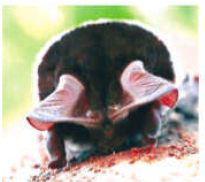
Significant Sighting in Delhi
- The recent spotting of Wroughton’s free-tailed bat at the Delhi Development Authority’s Yamuna Biodiversity Park marks a rare and unique occurrence.
- Primarily known from the Western Ghats and small colonies in Meghalaya and Cambodia, this species is seldom seen beyond its usual habitats.
- This finding underscores the biodiversity park’s importance as a haven for rare and elusive species.
Distinct Characteristics of the Species
- Wroughton’s free-tailed bat is notable for its large size, prominent ears extending beyond its muzzle, and its bicoloured velvet-like fur.
- It typically roosts in caves or dark, slightly warm locations, forming moderate colonies.
- These bats play a crucial ecological role in regulating insect populations and assisting in pollination, contributing significantly to ecosystem balance.
Ecological Importance and Conservation Status
- Once deemed critically endangered due to its single known population in the Western Ghats, the bat’s status has been revised to “data deficient” by the IUCN after discoveries in Meghalaya and Cambodia.
- Despite over a century since its discovery, much remains unknown about its feeding ecology.
- Its powerful flying capabilities enable foraging over long distances, highlighting its adaptability and ecological role.
Delhi’s Rich Bat Biodiversity
- The sighting of Wroughton’s free-tailed bat enriches Delhi’s bat diversity, already home to 14 species, four of which were previously considered locally extinct.
- Ecological restoration efforts over two decades have created specialized niches in Delhi’s biodiversity parks, fostering unique habitats.
- For instance, the Aravali Biodiversity Park hosts the only known roosting site for Blyth’s horseshoe bat in the region.
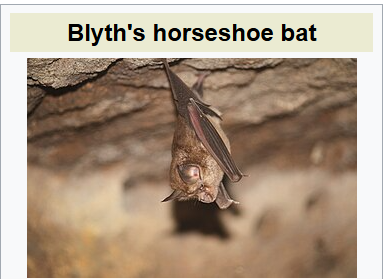
This discovery reaffirms the success of biodiversity parks in urban conservation and their role in preserving species beyond their known habitats.
2. France rushes aid to Mayotte after cyclone
(Source – The Hindu, International Edition – Page No. – 14)
| Context |
|
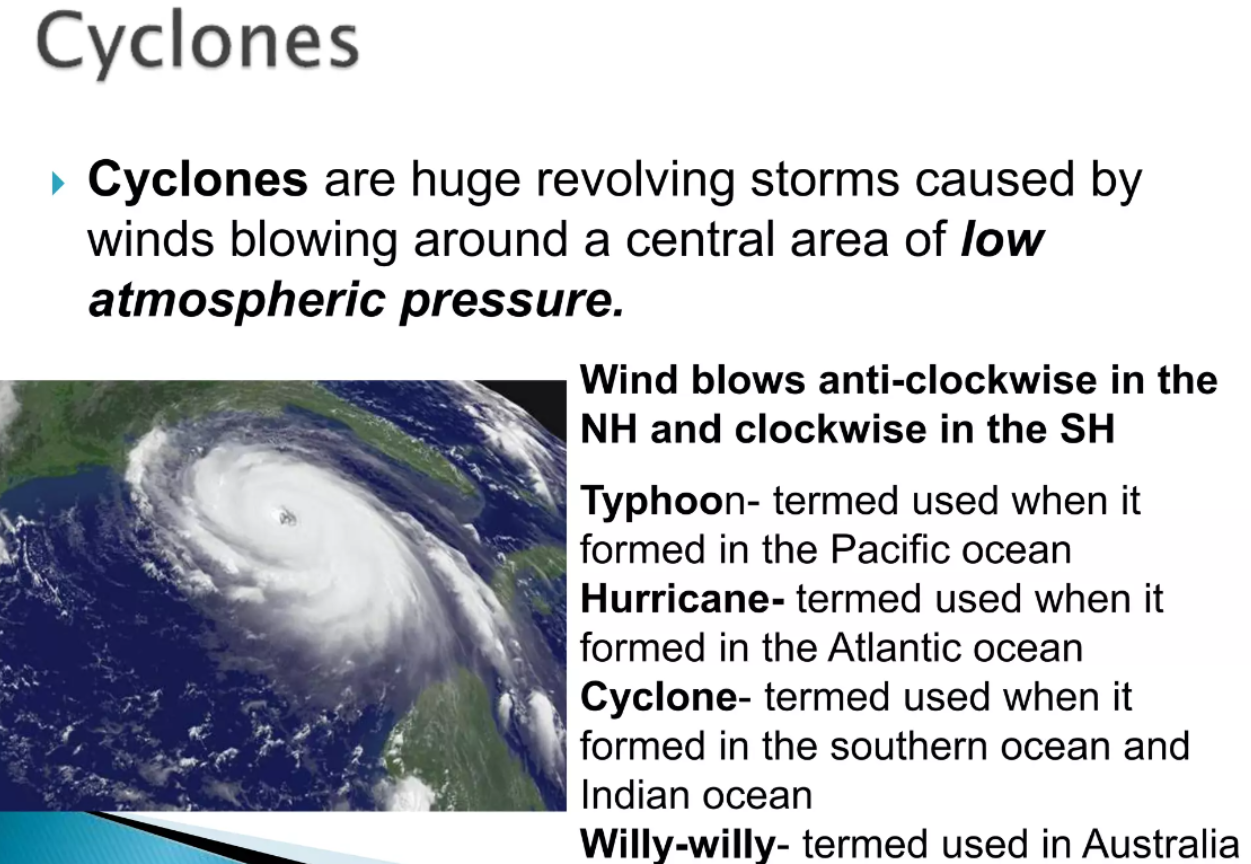
Cyclone Chido:
- Formed in early December 2024 in the South-West Indian Ocean.
- Peaked as a Category 4-equivalent intense tropical cyclone.
- Made landfall in Agaléga (Mauritius) on December 11th.
- Brought devastating winds exceeding 155 mph and heavy rainfall.
- Struck Mayotte on December 14th, causing widespread damage and casualties.
- Considered the worst storm to hit Mayotte in 90 years.
- Also impacted Mozambique and Malawi with heavy rains and flooding.
- Dissipated near Zimbabwe on December 17th.
- Left thousands displaced and hundreds feared dead in Mayotte.
- Caused significant infrastructural damage in the affected regions.
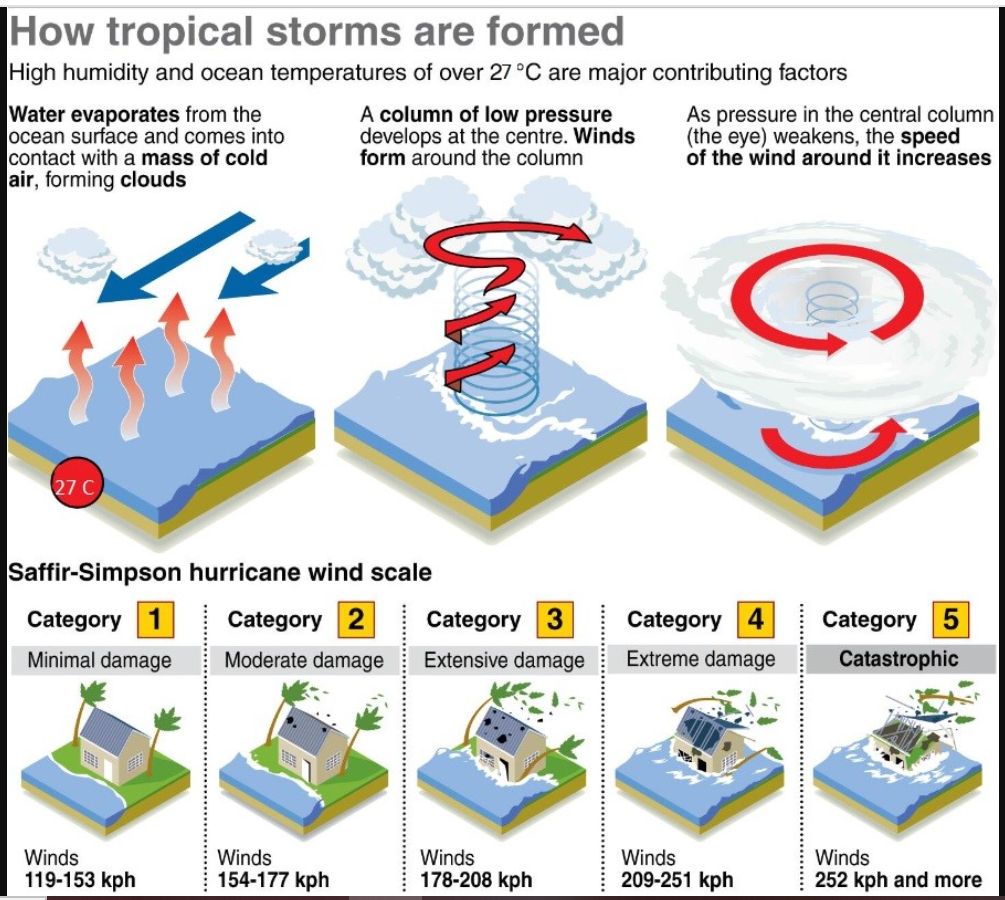
3. Financial Support for Rural Women
(Source – https://pib.gov.in/PressReleseDetail.aspx?PRID=2085245®=3&lang=1 )
| Context |
|
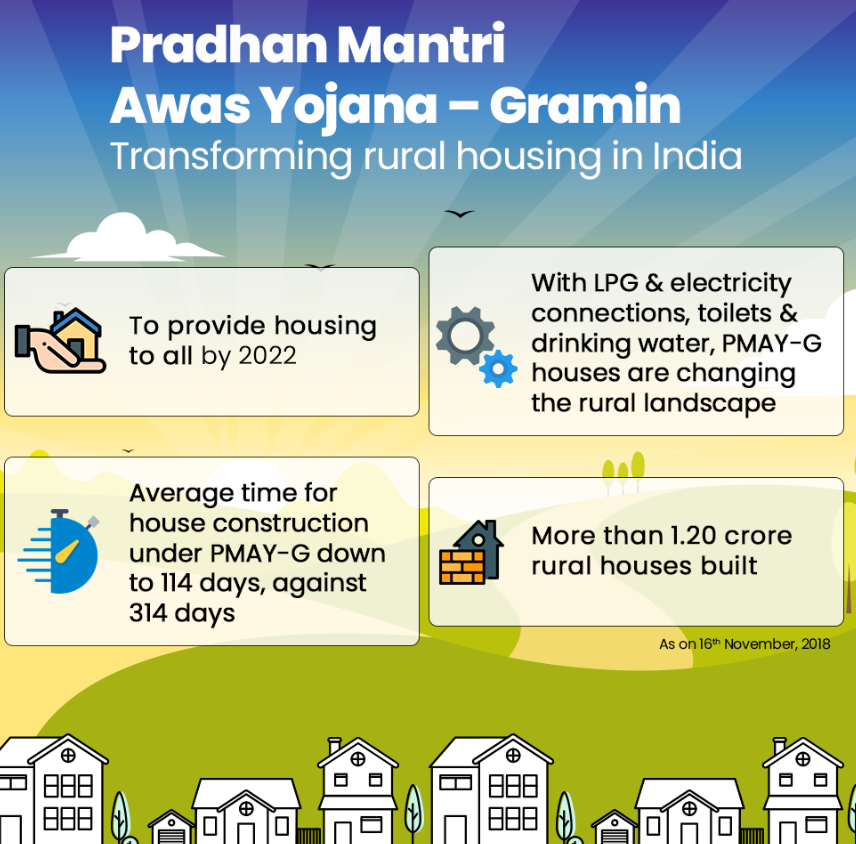
Pradhan Mantri Awaas Yojana- Gramin (PMAY-G)
- Launched in April 2016 with a target to construct 4.95 crore pucca houses by March 2029.
- 3.33 crore houses allotted to States/UTs; 3.22 crore sanctioned and 2.68 crore completed.
- Houses are to be sanctioned in women’s names or jointly with their husbands.
- 73% of completed houses are either in the name of women or jointly with their husbands.
- Women beneficiaries are linked with Self-Help Groups (SHGs) for livelihood support.
Deendayal Antyodaya Yojana- National Rural Livelihoods Mission (DAY-NRLM)
- Focuses on providing bank loans to Self-Help Groups (SHGs), especially women-led.
- Rs. 9.74 lakh crore in loans disbursed to women-led SHGs.
- 10.05 crore rural households mobilized into 90.87 lakh SHGs for empowerment and livelihood.


